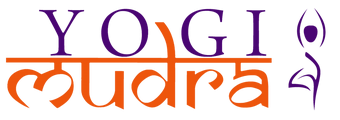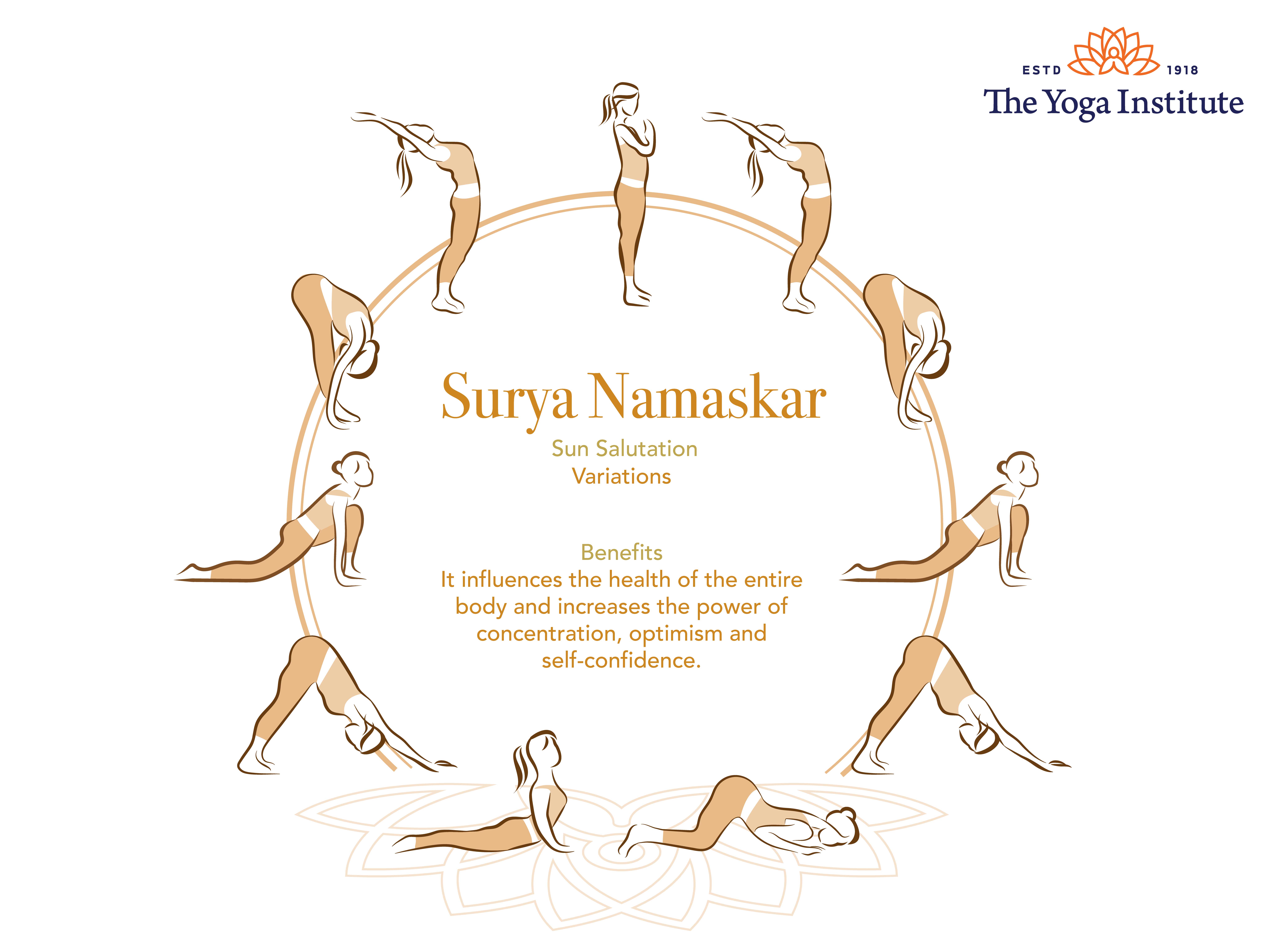Surya Namaskar or Sun Salutation is a technique of vitalization via solar energy. Invocation and worship of the Sun were one of the first and most natural forms of expression of awe and gratitude. Sun worship is still practiced as a daily ritual in many parts of India, as it is a powerful symbol of life energy.
Surya Namaskar is a series of twelve different physical movements. These movements consist of alternate backward and forward bending asanas, thereby flexing and stretching the spinal column and limbs to their maximum capacity. It massages, tones, stretches and stimulates all the muscles and vital organs of the body. It loosens up all the joints, massages the internal organs, activates the respiratory and circulatory system as well as helps all other systems of the body to function optimally. It harmonizes the whole body-mind complex.
Surya Namaskar consists of five essential aspects. All of them must be followed to gain optimum results. They are as follows:
- Asanas: There are twelve postures and the complete cycle consists of twenty-four movements, which have to be practiced in a sequence, one after the other, with retention of each position for a few seconds, if possible.
- Breathing: The complete cycle of Surya Namaskar is synchronized with breathing. Each posture is associated with either inhalation or exhalation or retention or suspension of breath.
- Mantra: Each posture is accompanied by a specific mantra repeated either silently or loudly. These mantras add to the benefits. Before integrating these mantras, it is advisable to first perfect the postures and synchronize them with breathing.
- Awareness: Awareness is a crucial part of this practice through which its effects are experienced at the cellular level. It increases the capacity of concentration and chanting brings about harmony at all levels.
- Relaxation: For beginners, after completing about three rounds, relaxation is important.
Method of Practice:
Posture 1: Sthita Prarthanasana—Standing Prayer Posture
- Begin by standing erect on the front of the mat with the hands at the sides.
Chant mantra: ‘Om Mitraya Namaha’ (Salutation to the friend of All).
- Stand erect with the feet together.
- Bring palms in namaste position and place them in front of your chest.
- Relax the body, maintain normal breathing and stay for 3 seconds.
Posture 2: Hasta Uttanasana—Raised Arm Posture
Chant mantra: ‘Om Ravaye Namaha’ (Salutation to the radiant One).
- Inhaling, raise both your arms and bend backward. Keep your arms close to your ears with your palms facing front.
- Maintain the position for 3 seconds.
Posture 3: Hasta Padasana—Hands to Legs Posture
Chant mantra: ‘Om Suryaya Namaha’ (Salutation to He who initiates all activity).
- Exhaling, bend forward, place your palms on the floor on each side of your feet.
- Keeping your legs straight, try to touch the forehead to the knees. Suspend the breath for 3 seconds.
Posture 4: Ashwa Sanchalanasana—Equestrian Posture
Chant mantra: ‘Om Bhanave Namaha’ (Salutation to He who illuminates).
- Keep both your hands fixed on the floor, inhaling extend your right leg backward, as far as possible. Your right toes should touch the floor.
- Arch the spine, look upwards and balance the body.
Posture 5: Adhomukha Shvanasana—Downward Dog Posture
Chant mantra: ‘Om Khagaye Namaha’ (Salutation to the All-pervading One).
- Exhaling, bring the left foot beside the right, simultaneously raise the hips and lower the head between the arms, so that the body forms an inverted V.
- Keeping the legs and arms straight, press the heels towards the floor and push the head lower. Sustain the posture for 3 seconds.
Posture 7: Urdhvamukha Shvanasana—Upward Dog Posture
Chant mantra: ‘Om Hiranyagarbhaya Namaha’ (Salutation to the golden cosmic womb).
- Inhaling, lower your hips to the ground. Simultaneously straighten your arms and raise your head to look up and arch your back. Check that your legs, knees, and toes remain together.
- Keep your arms and legs straight. Stay in this posture for 3 seconds retaining the breath.
Posture 8: Adhomukha Shvanasana—Downward Dog Posture
Chant mantra: ‘Om Marichaye Namaha’ (Salutation to the golden rays of the Sun).
- While exhaling from the Bhujangasana position, raise the hips upwards and push the head downwards and inwards to form an inverted V, being careful that the heels touch the floor.
- Remain in the posture for 3 seconds suspending the breath.
Posture 9: Ashwa Sanchalanasana—Equestrian Posture
Chant mantra: ‘Om Adityaye Namaha’ (Salutation to the son of Aditi, the Cosmic Mother).
- Keeping both your hands fixed, inhaling bring your right leg forward, placing the foot near the inside of your right hand.
- Simultaneously, arch your spine, look up and keep your arms straight. Hold the position for 3 seconds retaining your breath.
Posture 10: Hastapadasana—Hands to Leg Posture
Chant mantra: ‘Om Savitre Namaha’ (Salutation to the stimulating power of Sun).
- Exhaling, bring your left foot forward next to your right foot, straighten the legs keeping your hands fixed on the floor. Try to touch your forehead to your knee.
- Remain in this position, suspending the breath 3 seconds.
Posture 11: Talasana—Raised Arm Posture
Chant mantra: ‘Om Arkaya Namaha’ (Salutation to He who is worthy of praise).
- While inhaling, making sure that your head is held in between your arms, raise your arms and torso upwards.
- Remain in the posture for 3 seconds while retaining your breath.
Posture 12: Sthita Prarthanasana—Standing Prayer Posture
Chant mantra: ‘Om Bhaskaraye Namaha’ (Salutation to the One who leads to enlightenment).
- While exhaling, in a sweeping arc bring your hands together in a namaste position at your chest.
- Remain in this position for 3 seconds.
- Repeat all the steps with your other leg to complete one round of Surya Namaskar.
Limitations / Contraindications:
- High blood pressure, cardiac problems
- Vertigo
- Abdominal inflammation
- Sciatica, slipped disc
- Menstruation, hernia, pregnancy
- Any structural problems
Benefits:
Physical
- It influences the health of your entire body.
- It stimulates and improves all your organs.
- It strengthens your neck, shoulders, arms, wrists, fingers, back, stomach, waist, abdomen, intestines, thighs, knees, calves and ankles.
- It invigorates your nervous system
- It reduces the redundant fat, especially the fat near the abdomen, hips, thighs, neck, and chin.
Therapeutic
- It alleviates various diseases linked to the digestive system and removes constipation.
- It helps the elimination of toxins.
- It improves the vital capacity of your lungs.
- It improves the functioning of your endocrine system.
- It improves the quality and circulation of blood.
- It improves knock knees in walking.
- It helps to cope with insomnia.
- It helps regulate the menstrual cycle.
Psychological
- Gives you poise, mental as well as physical.
- It increases the power of concentration, optimism, and self-confidence.
- It increases emotional strength and spiritual growth.
Muscles Involved
- Nearly all muscles and muscle groups
- Mainly the vertebral muscles, cervical, thoracic, lumbar
- Extensor and flexor muscles of the abdomen, lower extremities, and arms


Good site you’ve got here.. It’s difficult to find excellent writing like
yours nowadays. I truly appreciate people like you! Take care!!